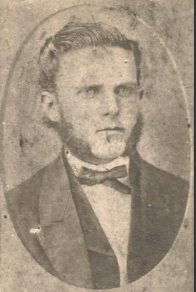Hermann Jaeger
| Hermann Jaeger | |
|---|---|
|
Hermann Jaeger, c. 1880 | |
| Born |
March 23, 1844 Brugg, Switzerland |
| Died |
May 1895, age 51 unknown |
| Occupation | enologist, scientific journalist, vintner, viticulturist, writer |
| Period | 1865–1895 |
Hermann Jaeger (March 23, 1844 – c.May 17, 1895)), a native of Switzerland, was a celebrated enologist, honored as a Chevalier of the Ordre National du Mérite Agricole for his part in saving the French wine industry from the phylloxera root louse pest.
Early life
Jaeger, sixth of Charles and Mary (Custer) Jaeger's seven offspring, came from a well-known and highly educated family. His mother Mary's grandfather was Johann Heinrich Pestalozzi, founder of the Swiss public school system. As a young man Jaeger took a job in a wine warehouse on Lake Geneva in Switzerland and then emigrated to the United States. In 1865, just after the end of the American Civil War, he settled east of Neosho, in the Monark Springs, Missouri area of Newton County. The following year he and his brother, John, planted a vineyard and became grape growers and wine makers.
Marriages and Children
In 1872, Jaeger married Eliza Wagenrieder of St. Louis, Missouri; his brother John had earlier married Eliza's sister Anna in 1866. Eliza died at the age of 19 on October 11, 1873 shortly after giving birth to a daughter, Bertha. In 1874, Jaeger married Elise Grosse (1854–1913), also of Saint Louis. Together, they had four children, Herman (1878–1923), Lena (born 1881), Emma (born 1884), and Carl (1892–1950).
Viticulture
Intelligent and proficient in several languages, Hermann Jaeger worked to breed over 100 new varieties of grapes, many of which came from wild Ozarks grapes - grapes commonly called "possum grapes". He also became the first grower in the Western world to spray vines to control fungal disease. He readily communicated with other grape experts around the world, sharing information about his work and learning from the works of others. He also wrote articles for scientific and grape journals, explaining the mysteries of grapes and his work on his farm.
Work with phylloxera
After the spectacular success of Missouri wines at the Vienna World Fair of 1851, taking 8 of the 12 medals on offer, the French responded by importing Norton / Cynthiana rootstocks from the USA, and unwittingly introducing phylloxera, which then ravaged the vineyards of France, Spain, and Portugal during the 1870s. Jaeger, working with the Missouri state entomologist George Hussman, had already raised vines with resistance to the pest; he exported 17 boxcars of the resistant rootstock to France, which was to prove the salvation of the European wine industry. .[1] In 1893, for his contribution to the grape and wine industries of France, Jaeger was made Chevalier of the Légion d'honneur. Jaeger also made a lasting contribution to viticulture through his selection Jaeger 70, which is an ancestor of many of today's hybrid grapes.
Business problems
For all his success, Jaeger was to be beset by financial problems in the 1890s following the passing of a local law, many years ahead of Prohibition, banning the sale of alcohol in Newton County. When his attempts at circumventing the law resulted in indictment, Jaeger sold his Neosho vineyard and moved to lands near Joplin, Missouri, where he intended growing fruit and starting a new vineyard.[1]
Death
On 16 May 1895, Hermann Jaeger bade farewell to his wife and children, telling them he was returning to Neosho to address legal matters. He was never seen by his family again. Several days later, his wife received a letter from him postmarked Kansas City, 157 miles away. Written in German, the letter read 'When you read these lines, I will be alive no more' and making it clear his body would never be found. He signed the letter 'your unlucky Hermann'.[1]
References
- Letner, J. (2012). Neosho to honor contribution of winemaker with festival. Joplin Globe, 13 March 2012. Joplin, MO.
